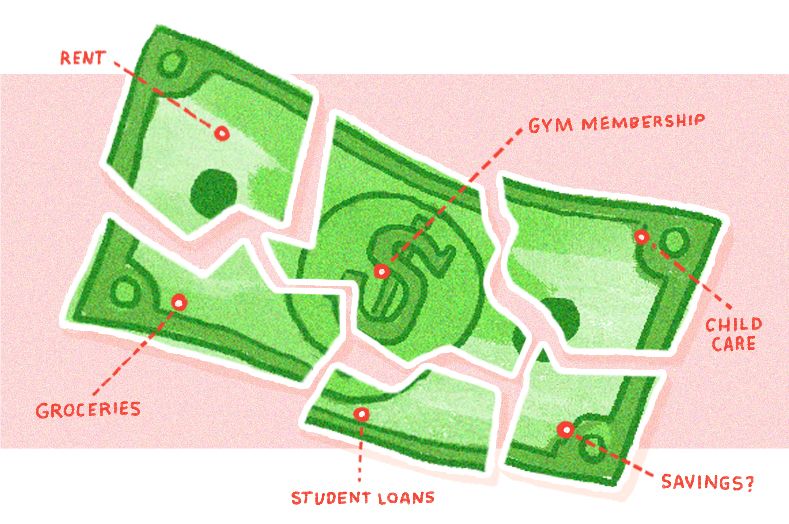
You gotta live your life and pay your rent. But by this point, you’ve also (hopefully!) prioritized saving. But how much of your paycheck should you save? We checked in with Ashley Feinstein Gerstley, founder of the Fiscal Femme and author of The 30-Day Money Cleanse, to get her take. Her answer is that it varies. After all, while many experts tout the 50-30-20 rule (where you set aside 20 percent of your paycheck, no matter how much you earn), it’s simply not realistic for many Americans.
So, where should you start? We asked Gerstley to help four real women with their income-to-savings ratios. (Psst: use this online savings calculator to do your own math.)
1. A New York City Renter Making $55,000: Set Aside 10 Percent
Take-Home Pay: Approximately $35,000 after 401(k), taxes and benefits
Gerstley Says: Since most of your salary is going to rent and utilities—around $17,000—that leaves $200 a month to spend on other bills, plus $200 per week to spend on food, entertainment and incidentals like clothing, gifts or vacations. (This totals $13,000 per year.) What remains? $4,500 per year that you can sock away in a rainy day fund, which nets out to $173 per paycheck, assuming you’re paid every two weeks.
Savings Total: $7,250. (This includes a 5 percent 401(k) contribution.)
2. A Married North Carolinian (With Credit Card Debt) Making $100,000: Pay Off Debt First
Take-Home Pay: $65,000 after your 401(k), taxes and benefits
Gerstley Says: Let’s assume your credit card debt is around $15,000 and you also have student loans, which require you to shell out $500 a month ($6,000 per year). This means you should hold off on contributing to a savings fund in order to focus on whittling your debts. (You should, however, continue to contribute to your 401(k) as much as is required to meet your company match.) You’re married, which means you can split the cost of housing and utilities—let’s say that totals $15,000/year and you’re spending another $20,000 on fixed expenses. Let’s reserve another $5,000 for vacations and gifts. If you didn’t have debt, the remaining $19,000 of income would go to savings But since you do, you should absolutely use it to pay off that debt (approximately $731 per biweekly paycheck).
Savings Total: $3,000. (The amount of your 401(k) contribution.) But once you clear your debt, you can begin saving an additional $19,000 annually.
3. A Single Chicagoan Making $150,000: Set Aside 25 Percent
Take-Home Pay: $85,000 after your 401(k), taxes and benefits
Gerstley Says: A high paycheck puts you in a strong position to max out that 401(k) contribution and amp up the amount you contribute to a savings fund. So, if you’re spending $36,000 annually (about $3,000 a month) on your mortgage and utilities, that leaves $25,000 (or $1,000 per paycheck) for fixed expenses. Let’s allow another $9,000 a year to spend on travel and other splurges. Back to your 401(k): Now that you’ve increased your contributions to 13 percent, you’re setting aside $19,500 there. But you also took out an IRA ahead of the tax deadline to make up for lower contributions the previous year. (You put $6,000 there.) That leaves you with $9,000 ($346 per paycheck) for a rainy day fund.
Savings Total: $35,000 (This includes a 13 percent 401(k) contribution plus $6,000 towards an IRA.)
4. A Married Floridian With Kids Making $250,000: Set Aside 25 Percent
Take-Home Pay: $168,000 after your 401(k), taxes and benefits
Gerstley Says: While you may pay the bulk of your monthly mortgage ($24,000 per year), you also have two kids, which costs you $17,000 a year for childcare, camp and activities. You put another $5,000 a year into a 529 college fund, and your family’s fixed expenses add up to $30,000 a year. You also have $150,000 in undergrad and grad school loans, which require a monthly payment of $1,500 ($18,000 a year with an interest rate of 6 percent). In addition, you help your mom with her assisted living payments—another $18,000 annually. Your 401(k) contribution is at it’s max ($19,500) and you have aspirations to start your own business someday, so you set aside $38,000 this year (about $1,600 per paycheck). You also had to shell out for some unexpected home repairs including a new air conditioner unit. (That totaled $12,000)
Savings Total: $62,000 (This includes the max 401(k) contribution, plus the business fund savings goal and 529 contribution.)
























